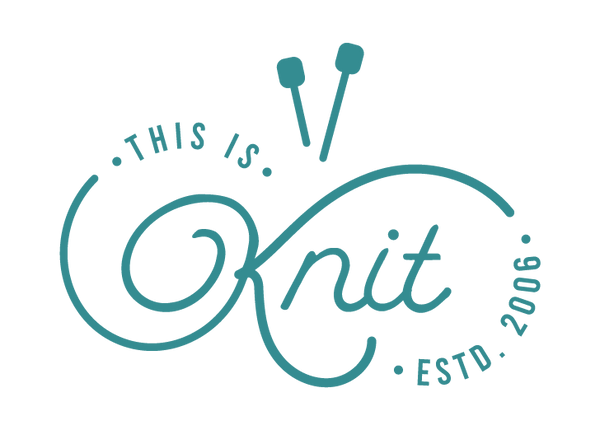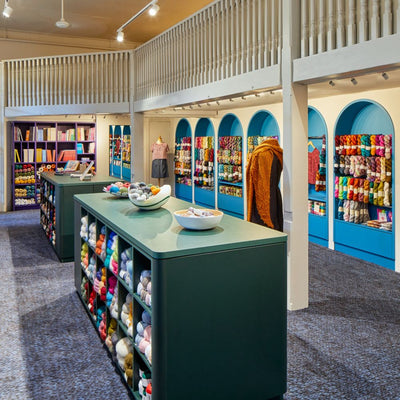YO ho ho!
June 05 2012 – thisisknit
 We encounter a lot of yarn overs at This Is Knit. We also get a lot of questions about how to do them, and so we thought a tutorial would be useful.
The picture above shows the finished product, a yarn over one row after it's been made, showing the hole that's been created. And here's how to do it.
We start with the yarn at the back of the work - we're on a knit row here, so that's where it's naturally to be found (we'll talk a bit later about what to do if you're purling).
We encounter a lot of yarn overs at This Is Knit. We also get a lot of questions about how to do them, and so we thought a tutorial would be useful.
The picture above shows the finished product, a yarn over one row after it's been made, showing the hole that's been created. And here's how to do it.
We start with the yarn at the back of the work - we're on a knit row here, so that's where it's naturally to be found (we'll talk a bit later about what to do if you're purling).
 Bring the yarn to the front of the work between the needles, just as if you were going to purl the next stitch, and stop there for a moment.
Bring the yarn to the front of the work between the needles, just as if you were going to purl the next stitch, and stop there for a moment.
 That's the yarn over pretty much done. You still have to work the next stitch, but that's none of the yarn over's business. In other words, a yarn over doesn't use up a stitch.
So on we go to the next stitch, then. Since the yarn's at the front of the work, just knitting the next stitch will bring the yarn over the top of the right hand needle.
That's the yarn over pretty much done. You still have to work the next stitch, but that's none of the yarn over's business. In other words, a yarn over doesn't use up a stitch.
So on we go to the next stitch, then. Since the yarn's at the front of the work, just knitting the next stitch will bring the yarn over the top of the right hand needle.
 When you've worked that next stitch, you'll see what's happened: the yarn over is a strand of yarn over the needle between two stitches.
When you've worked that next stitch, you'll see what's happened: the yarn over is a strand of yarn over the needle between two stitches.
 It's worth while pointing out that patterns have two ways of telling you to do this manoeuvre. UK patterns, especially older ones, will tell you "yarn forward, knit 1", which is exactly what we've done in these pictures. US patterns (and increasingly, patterns from elsewhere as well) tell you "yarn over, knit 1". In other words, the UK version emphasises the action (the yarn is brought forward) while the US version tells you the result (the yarn lies over the needle), usually abbreviated to YO. So if you come across either of these, they're essentially telling you the same thing.
But what if you want to work a yarn over before a purl stitch? This will happen any time you're making yarn overs on a purl row, but it could also happen in a lacy rib. The yarn starts at the front of the work - bring it there as before if the last stitch was a knit, and it's already at the front if the last stitch was a purl. It loops right round the right hand needle, backwards over the top and returning to the front between the needles:
It's worth while pointing out that patterns have two ways of telling you to do this manoeuvre. UK patterns, especially older ones, will tell you "yarn forward, knit 1", which is exactly what we've done in these pictures. US patterns (and increasingly, patterns from elsewhere as well) tell you "yarn over, knit 1". In other words, the UK version emphasises the action (the yarn is brought forward) while the US version tells you the result (the yarn lies over the needle), usually abbreviated to YO. So if you come across either of these, they're essentially telling you the same thing.
But what if you want to work a yarn over before a purl stitch? This will happen any time you're making yarn overs on a purl row, but it could also happen in a lacy rib. The yarn starts at the front of the work - bring it there as before if the last stitch was a knit, and it's already at the front if the last stitch was a purl. It loops right round the right hand needle, backwards over the top and returning to the front between the needles:
 That's the yarn over completed, so it's on to the next stitch, which is going to be purled:
That's the yarn over completed, so it's on to the next stitch, which is going to be purled:
 And this is the result - a yarn over before a purl (and in this case, after a knit):
And this is the result - a yarn over before a purl (and in this case, after a knit):
 On the next row, you'll spot the yarn overs easily. They're just strands of yarn lying lazily across the left hand needle, and when you come to one, you work its front leg.
On the next row, you'll spot the yarn overs easily. They're just strands of yarn lying lazily across the left hand needle, and when you come to one, you work its front leg.
 If you work the back leg instead, you'll twist the yarn over, making the eyelet smaller and less obvious.
Every one of the eyelets in a piece of lace is made from a yarn over, and they make very handy buttonholes, especially in children's garments. You can thread ribbon through a line of them at the top of a knitted gift bag and you can make a set of decorative increases on a raglan jumper with them. But sometimes we forget to put them where they're supposed to be, and that's going to be the subject of an upcoming post: how to fix a missing yarn over. And you won't have to rip out a single stitch. We promise.
If you work the back leg instead, you'll twist the yarn over, making the eyelet smaller and less obvious.
Every one of the eyelets in a piece of lace is made from a yarn over, and they make very handy buttonholes, especially in children's garments. You can thread ribbon through a line of them at the top of a knitted gift bag and you can make a set of decorative increases on a raglan jumper with them. But sometimes we forget to put them where they're supposed to be, and that's going to be the subject of an upcoming post: how to fix a missing yarn over. And you won't have to rip out a single stitch. We promise.


1 comment
[…] A few blog posts back, we promised that we’d show you how to fix a missing yarn over. It’s very straightforward, and it will save you a lot of ripping back. In this post, we’ll show you both how to deal with the issue both immediately after it happens and when you only realise a couple of rows later what’s happened. […]